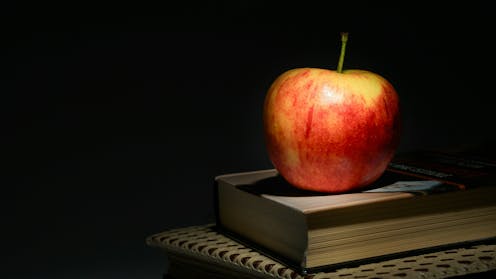In Australia, the rules around academics sleeping with their students can be complicated. But is it ethical?
- Written by Camilla Nelson, Associate Professor in Media and Journalism, University of Notre Dame Australia

In Sweet Nothings, author Madison Griffiths investigates the uncomfortable complexities of “problematic sex” between academics and students on Australian university campuses.
The term “problematic sex” – often used by Gen Z and younger millennial feminists – refers to sexual relationships that, while technically “consensual”, are nonetheless harmful for other reasons, most often due to significant disparities of power.
Review: Sweet Nothings: Power, lust and learning – Madison Griffiths (Ultimo)
Griffiths’ book tells the stories of four women now in their 30s and 40s, all of whom entered into a sexual relationship with an academic at the university where they studied while in their early 20s. Griffiths explores how these experiences left three of them psychologically damaged or, in Griffiths’ words, feeling “angry”, “bitter”, “betrayed”, and “small and expendable”.
Griffiths was also once in a relationship with a man who had been her university tutor. As she writes in an author’s note:
In my late teens, I was once a man’s student.
In my early twenties, his lover. In my early thirties, a thorn in his side. I had discovered, over the span of a decade, that there had been others he had loved, or at least held: a small handful of students-turned-lovers.
The memory prompted her to post an appeal on Instagram for people to come forward who had once been in a relationship with their “teacher, tutor, professor or student”. She received hundreds of responses, ultimately meeting with her four interviewees.
“It started to appear obvious to me that sex between university students and their superior felt contaminated by larger, more damning forces,” she writes.
Appearing trusting and professional
Sweet Nothings focuses on Rose, Blaine, Cara and Elsie and their relationships with four men. The identities of all individuals – both protagonists and antagonists – are masked, although the action mostly unfolds against a recognisable Melbourne landscape.
Rose’s story revolves around Samuel, a sessional lecturer who has pursued at least three sexual relationships with female undergraduates he teaches across different institutions.
Blaine’s story revolves around her sexual encounters with Greg, an older, married professor who has spent much of the past three decades engaging in sexual relationships with his female students. Often these liaisons occur in the back rooms and side corridors of the campus where he teaches. At one point, he accepts an appointment as mid-candidature assessor for Blaine’s PhD. He “minced her thesis to bits” – in order, Griffiths suggests, “to divert attention from the two of them” and appear “trusting, professional in front of his colleagues”.
Elsie enters into a sexual relationship with her middle-aged doctoral supervisor Harrison, in the aftermath of his marital separation. “I need to know,” she says when she confronts him with the “wrongness” of their relationship, years later. “When did you realise you were using me?”
The fourth story centres on Ivan, who has a chaste but intense relationship with Cara. “Nothing happened,” Cara insists. “You see, it was all very gentle, which is why I can’t understand you wanting to speak to me.”
In some ways, Cara is a foil for the other women in the book, although Griffiths also paints Ivan as emotionally creepy.
Griffiths spoke to male professors and tutors who had slept with a student. But to protect her four subjects’ anonymity, she did not speak to the men they were involved with.
Obscure language – and lots of arguments
Despite serial inquiries into sexual harms on campus, “consensual” sexual relationships between academics and students remain an ethically grey area in Australia: the rules that govern them vary between institutions. There are few conclusive prohibitions, and most of those that do exist refer specifically to relationships of a supervisory nature.





